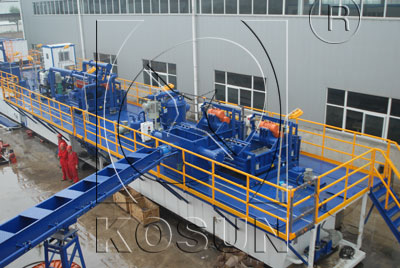Sep 01, 2013
In geotechnical engineering, drilling fluids is used to aid the borehole drilling in the ground. Often used while drilling oil and natural gas wells and on exploration drilling rigs, drilling fluids are also used for much simpler boreholes, such as water wells. Liquid drilling fluids is often called drilling mud. The three main categories of drilling fluids are water-based muds ( which can be dispersed and non-dispersed ), non-aqueous muds, usually called oil-based mud, and gaseous drilling fluids, in which a wide range of gases can be used.
The main functions of drilling fluids include providing hydrostatic pressure to prevent formation fluids from entering into the well bore, keeping the drill bit cool and clean during drilling, carrying out drill cuttings, and suspending the drill cuttings while drilling is paused and when the drilling assembly is brought in and out of the hole. The drilling fluids used for a particular job is selected to avoid formation damage and to limit corrosion.
Water-based mud ( WBM ): Most basic water-based fluids begin with water, then clays and other chemicals are incorporated into the water to create a homogenous blend resembling something between chocolate milk and a malt ( depending on viscosity ). The clay ( called " shale" in its rock form ) is usually a combination of native clays that are suspended in the fluids while drilling, or specific types of clay that are processed and sold as additives for the WBM system. The most common of these is bentonite, frequently referred to in the oilfield as "gel". Gel likely makes reference to the fact that while the fluids is being pumped, it can be very thin and free-flowing (like chocolate milk), though when pumping is stopped, the static fluids builds a "gel" structure that resists flow. When an adequate pumping force is applied to "break the gel", flow resumes and the fluids returns to its previously free-flowing state. Many other chemicals ( e. g. potassium formate ) are added to a WBM system to achieve various effects, including: viscosity control, shale stability, enhance drilling rate of penetration, cooling and lubricating of equipment.
Oil-based mud ( OBM ): Oil-based mud can be a mud where the base fluid is a petroleum product such as diesel fuel. Oil-based muds are used for many reasons, some being increased lubricity, enhanced shale inhibition, and greater cleaning abilities with less viscosity. Oil-based muds also withstand greater heat without breaking down. The use of oil-based mud has special considerations. These include cost, environmental considerations such as disposal of cuttings in an appropriate place to isolate possible environmental contamination and the exploratory disadvantages of using oil based mud, especially in wildcat wells due inability to analyze oil shows in cuttings, because the oil-based mud has fluorescence dissolving with the original oil of formation, thus inducing contamination of cuttings samples, cores, sidewall cores for geochemical analysis of TOC and covering the real determination of API gravity due to this contamination.

Synthetic-based fluids ( SBM ) ( otherwise known as Low Toxicity Oil-Based Mud or LTOBM): Synthetic-based fluids is the mud where the base fluids is a synthetic oil. This is most often used on offshore rigs because it has the properties of an oil-based mud, but the toxicity of the fluid fumes are much less than an oil-based fluids. This is important when men work with the fluids in an enclosed space such as an offshore drilling rig. The same environmental problems and contamination for analysis of rock samples occur by using synthetic-based fluids.
On a drilling rig, mud is pumped from the mud pits through the drill string where it sprays out of nozzles on the drill bit, cleaning and cooling the drill bit in the process. The mud then carries the crushed or cut rock (" cuttings" ) up the annular space (" annulus" ) between the drill string and the sides of the hole being drilled, up through the surface casing, where it emerges back at the surface. Cuttings are then filtered out with either a shale shaker, or the latest shale conveyor technology, and the mud returns to the mud pits. The mud pits let the drilled " fines" settle; the pits are also where the fluids is treated by adding chemicals and other substances.
The returning mud can contain natural gases or other flammable materials which will collect in and around the shale shaker/conveyor area or in other work areas. Because of the risk of a fire or an explosion if they ignite, special monitoring sensors and explosion-proof certified equipment is commonly installed, and workers are advised to take safety precautions. The mud is then pumped back down the hole and further re-circulated. After testing, the mud is treated periodically in the mud pits to ensure properties which optimize and improve drilling efficiency, borehole stability, and other requirements listed below.
Solids control is a technique used in drilling rig to separate the solids in the drilling fluids that are crushed by the drill bits and carried out of the well surface. Normally solids control system is consisted of five stages, including shale shaker, vacuum degasser, desander, desilter and centrifuge. Shale shaker is used to separate the big solids with diameter above 75μm, and 45~74μm for desander, and 15~44μm for desilter. Sometimes desander & desilter are combined as high efficient mud cleaner. When air enters the drilling fluids, vacuum degasser is used to separate the air. If no air is found in the mud, the degasser will work as a big agitator. All these equipment are mounted on the top of the mud tank. After separating the solids, the clean mud will be pumped into the borehole again.